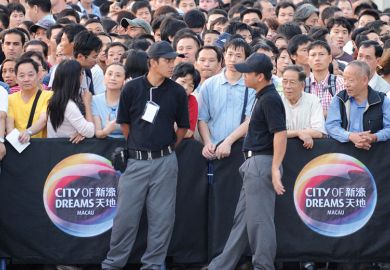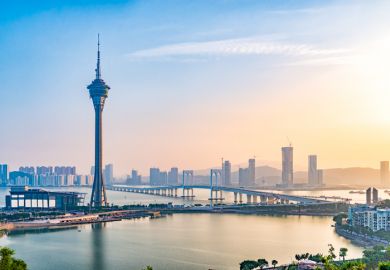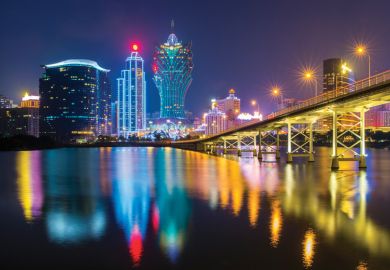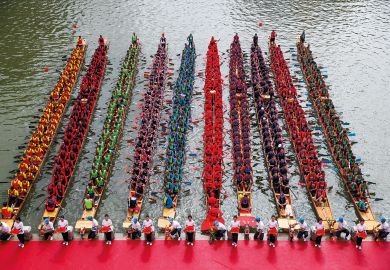Often dubbed the “Las Vegas of Asia”, at first glance the gambling hotspot of Macao might seem an unlikely meeting point for international universities and mainland China.
But despite what the prevalence of casinos and mega-malls might suggest, the region has long been a place of cultural fusion, explained Joseph Hun-Wei Lee, president of Macau University of Science and Technology (MUST).
“It took me more than three years to appreciate the strategic importance of Macao,” he said. “Macao was the first East-meeting-West place.”
Before it was handed over to China in 1999, Macao had been under Portuguese control for almost 500 years, during which time it became an important trading post and a key route into China for Westerners.
Since the turn of the 20th century, it is neighbouring Hong Kong that has become the international face of an often-shrouded society. But now, at a time when global relationships with China are coming under scrutiny, Professor Lee believes that Macao can once again serve as a meeting point between East and West.
“Forget temporarily about geopolitics,” he said. “I think on certain issues [and] grand challenges that are common to mankind…maybe Macao can be a useful bridge again, 500 years later.”
This time, instead of spices and silks, the goods being exchanged are less tangible: students, faculty and research.
“For Macao, it’s still at the beginning because the economy only really took off in the 2000s,” Professor Lee said. “With the development of the economy came funding for higher education and research.”
MUST, a private university, was established in 2000 and has since grown to accommodate 21,000 students, the majority from mainland China.
“The development of MUST paralleled the development of Macao,” Professor Lee said, describing the first 10 years of the institution’s existence as spent “building the blocks” and the second 10 “building the research”.
Campus resources on internationalisation in higher education
Now, a priority for the university is opening up to the wider world. “I think our attraction and our contribution to the region and country is the fact that we are international,” Professor Lee said, “but a bit different from Hong Kong.”
The civil engineer has been at the helm of MUST for three years, having formerly held senior positions at the University of Hong Kong and Hong Kong University of Science and Technology.
While he believes Hong Kong is about 20 years ahead of Macao when it comes to higher education and research, what made Macao unique, he said, was its connections with continental Europe and Portuguese-speaking countries. It is these areas, along with countries covered by China’s Belt and Road initiative, that the university is targeting as it attempts to go global, primarily through student and staff exchanges.
“Right now, we actually have many collaborators internationally that come to us wanting to collaborate, but we are very careful [about] how we actually move,” he said.
Looking ahead, another key priority for the university is increasing interdisciplinarity. Last year, the institution reorganised all its science and technology departments to sit under one umbrella. “Our physicists, mathematicians and engineers will be working seamlessly with clinicians [and] medical doctors,” Professor Lee explained. The university also offers courses in subjects including law, business, economics, tourism, management, and languages.
The goal is to prepare students for working in the Greater Bay Area, a region comprising Hong Kong, Macao and nine Chinese cities, the development of which the mainland government is keen to prioritise. As high youth unemployment remains a concern in China, leaders hope the internationalised economy being developed there will provide opportunities for the region’s graduates.
“Our aim is to train the engineers for the future innovation economy needed for the Greater Bay Area,” said Professor Lee. “Macao has always been searching for…a suitable diversification of the economy, and innovation technology fits into this very well.”
And, despite their differences, Professor Lee believed Hong Kong and Macao can complement and learn from one another. The university’s clinical research centre, for example, has been developed in “very close collaboration” with the University of Hong Kong, with surgeons from the region delivering lectures in Macao.
“We envision a Macao that becomes a new bridge between the East and the West, but in a different way,” he added. “Maybe a bridge that can showcase real accomplishments in China, for example, in an objective way to…the world.
“It has to be done, in my view, together with Hong Kong.”
POSTSCRIPT:
Print headline: ‘We see Macao as a bridge between West and China’
Register to continue
Why register?
- Registration is free and only takes a moment
- Once registered, you can read 3 articles a month
- Sign up for our newsletter
Subscribe
Or subscribe for unlimited access to:
- Unlimited access to news, views, insights & reviews
- Digital editions
- Digital access to THE’s university and college rankings analysis
Already registered or a current subscriber?










